Sophia spreading milkweed seeds on September 29, 2007
Olivia spreading milkweed seeds on September 28, 2007
That being said, we have noticed a overall decline in the number of monarchs in Minnesota over the years. One year, in fact, we literally spotted none all summer. That was highly unusual.
As we have spread more milkweed seeds annually, there does seem to be more monarchs that stay around our backyard - particularly a garden/overgrown area that has quite a bit of milkweed.
In the summer, the milkweed has such pretty and fragrant pink flowers. It's one of my favorite scents of the summer. Bees love to visit the flowers as do the monarch butterflies.
This year I found two caterpillars - one was the smallest one I've ever found and the other was about 1 5/8" long (almost a fully-grown caterpillar [they caterpillars grow to be about two inches long]). Both were found on the milkweed plants that we have in the backyard.
Something new we learned this year is that there are over 100 different types of milkweed plants in North America.
After we fed the caterpillars milkweed leaves daily, they eventually crawled to the top of the container and turned into chrysalises. The process goes very quickly - about ten minutes.
The caterpillar is almost done making the chrysalis.
September 1, 2007.
We are always amazed at the delicacy and beauty - with the little ring of gold "beads" around the top and bottom of the chrysalises.
The gold was more vivid in real life than in the picture.
September 1, 2014.
The gold beads are clearly visible throughout the entire chrysalis stage.
The gold beads can be more clearly seen here.
The butterfly is almost ready to hatch.
September 17, 2007.
The chrysalis is in the process of opening.
Some of the gold beads are still visible.
August 22, 2008.
While the caterpillars were transforming themselves into butterflies, the milkweed outdoors was going through a transformation process as well.
When we went out on a nature walk on September 5th, the milkweed pods were still rather hard and the seeds tightly packed. They were not ready to burst out and separate from one another as they found a new location to begin growing.
Sophia holding a milkweed pod on September 5, 2014.
The pods were green and hard. If you squeeze them, a sticky milk substance would come out. That's the indicator - at least to us - that the milkweed isn't ready to release its seeds.
We found out in the Handbook of Nature Study that the white juice "is a kind of rubber." The book suggests letting some of it dry on the back of your hand to see that it is "quite elastic and possessed of all the qualities of crude rubber."
The milk comes from the dark green ring encircling the stem cavity. It is not something that animals will consume for it has a rather bitter taste. The juice actually has a useful purpose, though, according to the Handbook of Nature Study: it helps heal the stem if it is somehow broken or gashed.
Some other facts we found out about milkweed include:
=> Monarchs lay their eggs on milkweed plants; hence monarch biology is tied closely to milkweed biology. They utilize most of the over 100 North American species in the milkweed family, the only group of plants that provide food for developing larvae.
Monarch egg - found on June 10, 2011.
=> Monarchs complete almost all of their growth during the larval stage. These insect “eating machines” take few breaks from eating milkweed leaves even to rest.
=> How many eggs each female butterfly lays during her life on milkweed leaves is hard tell. In the wild it is probably 300 to 400. Captive butterflies average about 700 eggs per female over 2-5 weeks of egg laying.
=> Monarch eggs and larvae have a slim chance of reaching adulthood; several previous studies document mortality rates of over 90% during the egg and larval stages. So, even though the milkweed leaves "hide" the egg and larvae, it doesn't guarantee reaching adulthood.
=> Abiotic (nonliving) factors that affect the survival of monarchs include environmental conditions such as adverse weather and pesticides. Biotic (living) factors that affect the survival of monarchs include natural enemies, and interactions with their milkweed hosts. Many monarchs in natural populations are killed by invertebrate predators that eat the monarchs themselves, or by parasitoids whose larvae developing and eventually kill the monarch larvae.
=> Monarchs have an effective chemical defense against many predators. They sequester cardenolides (also called cardiac glycosides) present in the milkweed. These compounds are poisonous to most vertebrates; hence monarchs face limited predation from fogs, lizards, mice, birds, and other animals with backbones.
Wood frog in our backyard.
There are a few milkweed plants in the ditches around our farm.
This lack of milkweed makes it difficult for monarchs.
September 25, 2014.
=> The local abundance and distribution of milkweed influence potential reproduction. When milkweed is rare and scattered, few plants are found by searching females, and full egg potential may not be realized.
=> The average birth to death distance of a non-migrating female is about 6.84 to 9.94 miles, depending on behavior between milkweed patches on inter-patch space. This is the average spatial scale at which environmental processes may influence the abundance of monarchs.
=> As milkweed becomes less abundant and more widely scattered, we would expect monarch abundance to decline.
September 5, 2014.
So, back to our direct experience with the caterpillars and butterflies now:
Five days after we were out exploring the milkweed, we were thrilled to see that the first caterpillar had fully transformed itself into a butterfly. She hatched in the morning and we let her dry out her wings and get stronger throughout the day before releasing her.
That afternoon (September 10, 2014) we released the first monarch of the summer. This was the larger caterpillar that we found in August.
The butterfly seemed quite content to rest on Sophia's finger while the girls observed her.
They looked at the butterfly from different angles to get a better look at the markings on her wings and her body. According to the Handbook of Nature Study:
=> There are white dots set, two pairs in two rows, between each two veins in the black margin of the wings; and the fringe at the edge of the wings shows corresponding white markings.
=> The monarch is an insect because it has six legs; but in this butterfly the front legs are so small that they scarcely look like legs.
=> The antennae are about two-thirds as long as the body and each ends in a long knob.
=> The male monarch has a black spot upon one of the veins of the hind wing. This is a perfume pocket and is filled with what are called scent scales. The lady monarch is attracted by this odor.
=> The viceroy looks like the monarch, but there is a black band on the wings which differentiates it from the monarch.
It was as if she could have stayed there all day. She was in no hurry to leave.
Finally, the girls transferred the butterfly to my finger and I walked with her to the garden.
Olivia and I found a spot to place her. I put her onto Olivia's sleeve-covered hand. She doesn't like the feel of the butterfly's feet walking on her skin.
No matter how much we moved, the butterfly just didn't want to go.
Finally, Olivia found a milkweed plant to do the transfer.
The butterfly seemed to look up at us and wonder why we were putting her outside. (It was a bit colder outside than inside that day.)
She opened her wings a few times.
And then found a nice place to settle herself. She seemed to prefer being on the underside of a milkweed leaf.
Five days later - on September 15th - the second butterfly emerged from her chrysalis. She clung to it for quite some time.
In the afternoon - after her wings dried out and were much stronger - we brought the container outside. This time Olivia wanted to put her on a purple flower we have growing in the backyard.
Before doing that, she put the butterfly on her sleeve-covered hand.
Then she carefully showed it the flower and transferred it to the plant.
The butterfly seemed to enjoy the flower.
She explored different ones and seemed very happy with her new (temporary) home.
On the 25th of September, we went outside to take a look at how the milkweed is doing. We have milkweed growing all over the farm since we've spread the seeds each fall.
Interestingly, the milkweed that was growing on the north part of the property in the shady areas still seemed a bit underdeveloped. There was the sticky white "milk" that came out of the pod at the end and on the sides in various spots.
The seeds - although not as tightly packed as a few weeks ago (on September 5th) - still were not quite ready to spread on their own or even with some assistance.
So, we went back to the east pasture where there are many milkweed plants and it's more sunny. These plants were further along in their development. Some of the pods had already burst open and seeds were scattered on the ground.
Others plants still had unopened pods, but when the girls opened them the seeds easily separated and floated into the air to new destinations.
Bailey seemed to enjoy watching the girls spread milkweed seeds.
Bailey was more interested than Hoss. Hoss preferred to eat. He would look up periodically, though, to make sure he wasn't far from us.
There's something magical about watching the seeds float into the air and wonder where they will land and begin their new life.
Sometimes it's pretty easy to see where a pod opened and the seeds fell to the ground. Some will stay here and others - very likely - will be carried off by the wind.
Olivia twirled around in circles as she spread the milkweed seeds.
She even found a very tall milkweed plant - taller than she is! - in the pasture. The pods are where her elbow and upper-arm are (high on the plant).
As we headed back, there were milkweed pods that had opened with some of the seeds still sitting nestled among the two sides of the pods.
The white, silky part that the brown, round seed is attached to is very soft...almost like an angora.
After we spent time outside, the girls finished up their nature journal entries.
They each included a milkweed seed on their page so they can remember the side and color of it.
Monarchs and milkweed will continue to be a major focus of our nature study in coming years. With each release, there's a sense of awe at having been a part of such a fascinating and beautiful journey.
The girls watching a butterfly they raised fly right in front of them.
August 23, 2008,
Even today - as I walked the dogs on a grassy-path between a neighbor's farm fields of corn and soybeans, I was inspired - and in awe - of seeing 23 migrating monarchs flying in the air and/or resting on the vivid-purple clover.
A monarch on goldenrod in the pasture.
August 27, 2010.
As long as we stay committed to developing and improving the habitat for monarchs, I'm hoping that we will continue to see them. I can't imagine our lives without them!
Links that we watched and/or will be referring to as we further study monarchs this year:
=> Monarch Migration (Journey North and Monarch Watch): Part 1 and Part 2.
=> Your Backyard The Life and Journey of the Amazing Monarch Butterfly.
=> Migration and Tagging
=> Do You Know a Monarch When You See One?
=> The Annual Cycle of the Monarch Butterfly
=> When, Where, and How to Watch the Fall Migration
=> Butterfly Wings
Note: We looked at the Butterfly challenge, Monarch Butterflies, and Milkweed pages on the Outdoor Hour Challenge for inspiration.

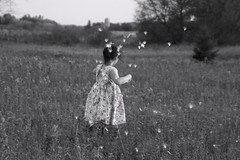

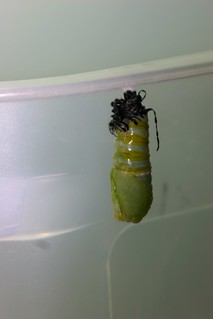


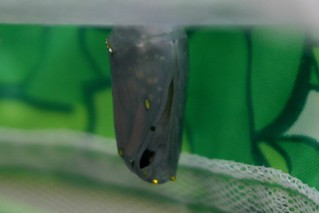

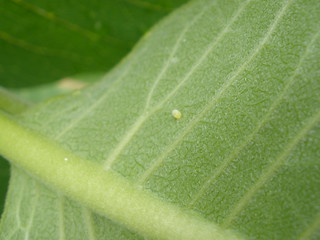
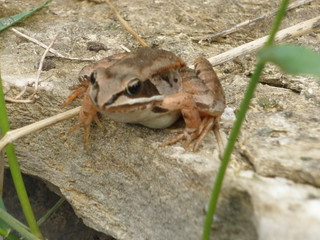


























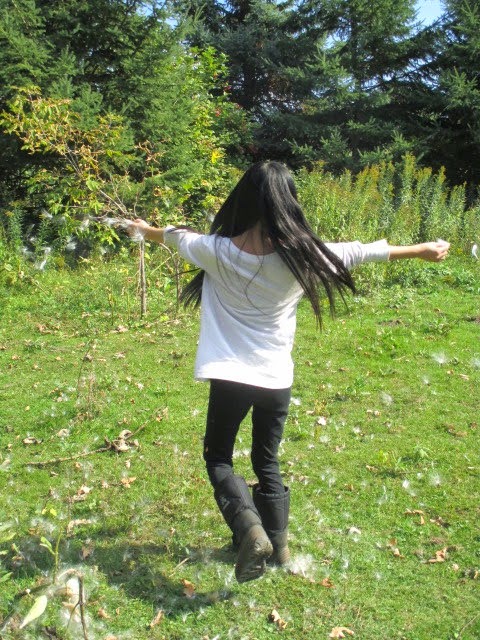








2 comments:
When I was little we had a field nearby that had lots of milkweed (minnesota) and I remember thousands of monarchs passing through every year. I loved to lay on the ground and watch them above me fly from plant to plant--the orange, black, and white against the blue sky. Then they dug up the field and built a school. And the monarchs never came back. I am thrilled to know you all are doing your best to propagate the milkweed plants for the monarchs. They have a special place in my heart. :) :)
Lovely post, Ann. It's wonderful that you've had such an extended time of observing the butterflies over the years. Nice nature journals, too!
Post a Comment